Design of an Optical Transparent Absorber and Defect Diagnostics Analysis Based on Near-Field Measurement
Abstract
:1. Introduction
2. Design, Fabrication, and Measurement of an Optical Transparent Absorber
2.1. Design of an Optical Transparent Absorber
2.2. Fabrication and Measurement
3. Defect Diagnostics Analysis
3.1. Measurement of Reflection Characteristics Based on Single Near-Field Antenna
3.2. Design and Validation of Defect Diagnosis Analysis Method
4. Conclusions
- I.
- A radio wave absorber with a high visible light transmittance (85.3% measured by Hazemeter) was designed, and the reflection/transmission and absorption characteristics of a sample fabricated via DC magnetron sputtering, which allowed for large-area (250 mm × 250 mm) fabrication, using a transparent conductor (indium-oxide-based TCO), were evaluated. The results confirmed a radio wave blocking of 97% and an absorption performance of 98.1% (Figure 4).
- II.
- To detect locally occurring defects in the transparent RAS and to analyze their influence on the electromagnetic performance, a reflection coefficient measurement system using a single near-field antenna was constructed, and a surface resistance prediction algorithm based on the equivalent circuit model was designed, whose effectiveness was also experimentally verified (Figure 8 and Figure 9).
Author Contributions
Funding
Institutional Review Board Statement
Informed Consent Statement
Data Availability Statement
Conflicts of Interest
References
- Saville, P. Review of Radar Absorbing Materials; Defense Research and Development Atlantic Dartmouth: Atlantic, Canada, 2005. [Google Scholar]
- Jenn, D. Radar and Laser Cross Section Engineering, 2nd ed.; American Institute of Aeronautics and Astronautics, Inc.: Washington, DC, USA, 2005. [Google Scholar] [CrossRef]
- Alves, M.A.; Folgueras, L.C.; Martin, I.M.; Da Silva, R.E.G.; De Abreu, A.J. The radar cross section of a military transport helicopter in the X-band. In Proceedings of the 2017 SBMO/IEEE MTT-S International Microwave and Optoelectronics Conference (IMOC), Aguas de Lindoia, Brazil, 27–28 August 2017; pp. 1–4. [Google Scholar] [CrossRef]
- Begaud, X.; Lepage, A.C.; Varault, S.; Soiron, M.; Barka, A. Ultra-wideband and wide-angle microwave metamaterial absorber. Materials 2018, 11, 2045. [Google Scholar] [CrossRef] [PubMed] [Green Version]
- D’Aloia, A.G.; Marra, F.; Tamburrano, A.; De Bellis, G.; Sarto, M.S. Electromagnetic absorbing properties of graphene–polymer composite shields. Carbon 2014, 73, 175–184. [Google Scholar] [CrossRef]
- Kim, J.B.; Byun, J.H. Salisbury screen absorbers of dielectric lossy sheets of carbon nanocomposite laminates. IEEE Trans. Electromagn. Compat. 2012, 54, 37–42. [Google Scholar] [CrossRef]
- Wang, H.; Zhang, Y.; Ji, C.; Zhang, C.; Liu, D.; Zhang, Z.; Lu, Z.; Tan, J.; Guo, L.J. Transparent perfect microwave absorber employing asymmetric resonance cavity. Adv. Sci. 2019, 6, 1901320. [Google Scholar] [CrossRef] [PubMed] [Green Version]
- Yi, D.; Wei, X.; Xu, Y. Transparent microwave absorber based on patterned graphene: Design, measurement, and enhancement. IEEE Trans. Nanotechnol. 2017, 16, 484–490. [Google Scholar] [CrossRef]
- Lai, S.; Wu, Y.; Wang, J.; Wu, W.; Gu, W. Optical-transparent flexible broadband absorbers based on the ITO-PET-ITO structure. Opt. Mater. Express 2018, 8, 1585. [Google Scholar] [CrossRef]
- Sheokand, H.; Singh, G.; Ghosh, S.; Ramkumar, J.; Ramakrishna, S.A.; Srivastava, K.V. An optically transparent broadband microwave absorber using interdigital capacitance. IEEE Antennas Wirel. Propag. Lett. 2019, 18, 113–117. [Google Scholar] [CrossRef]
- Li, W.; Shamim, A. Silver Nanowires Based Transparent, Broadband FSS Microwave Absorber. In Proceedings of the 13th European Conference on Antennas and Propagation (EuCAP), Krakow, Poland, 31 March–5 April 2019; pp. 1–3. [Google Scholar]
- Qiu, J.; Qiu, T. Fabrication and microwave absorption properties of magnetite nanoparticle–Carbon nanotube–Hollow carbon fiber composites. Carbon 2015, 81, 20–28. [Google Scholar] [CrossRef]
- Duan, W.; Yin, X.; Li, Q.; Schlier, L.; Greil, P.; Travitzky, N. A review of absorption properties in silicon-based polymer derived ceramics. J. Eur. Ceram. Soc. 2016, 36, 3681–3689. [Google Scholar] [CrossRef]
- Afre, R.A.; Sharma, N.; Sharon, M.; Sharon, M. Transparent conducting oxide films for various applications: A review. Rev. Adv. Mater. Sci. 2018, 53, 79–89. [Google Scholar] [CrossRef]
- Jiu, J.; Suganuma, K. Metallic nanowires and their application. IEEE Trans. Compon. Packag. Manuf. Technol. 2016, 6, 1733–1751. [Google Scholar] [CrossRef]
- Lee, I.G.; Yoon, S.H.; Lee, J.S.; Hong, I.P. Design of wideband radar absorbing material with improved optical transmittance by using printed metal-mesh. Electron. Lett. 2016, 52, 555–557. [Google Scholar] [CrossRef]
- Pozar, D.M. Microwave Engineering, 4th ed.; John Wiley & Sons: Hoboken, NJ, USA, 2011. [Google Scholar]
- Oh, S.-S.; Lee, Y.H. A low-cost method to evaluate absorber reflectivity using an antenna with a small radiating aperture and frequency-domain instrument. ETRI J. 2013, 35, 1148–1151. [Google Scholar] [CrossRef] [Green Version]
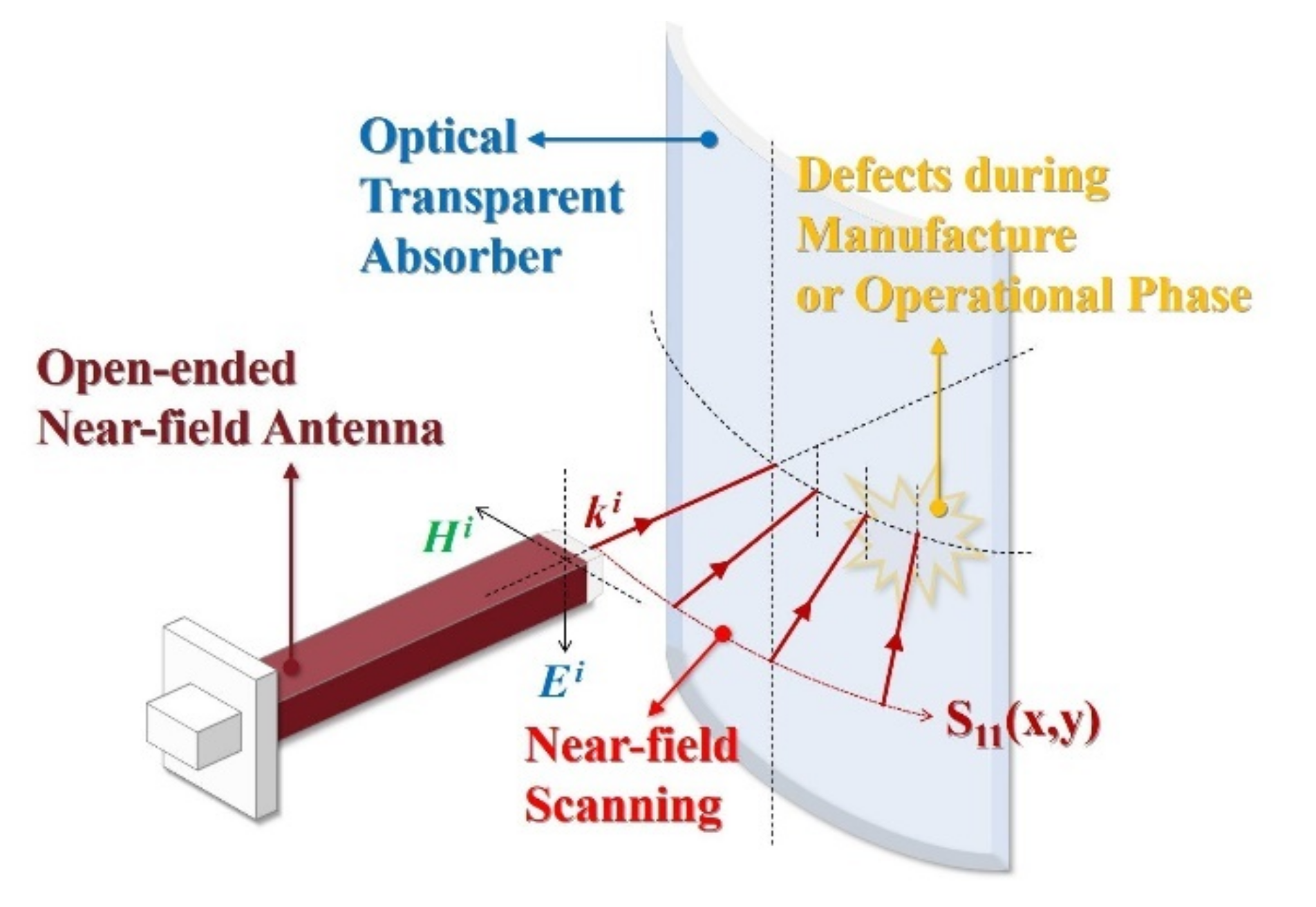

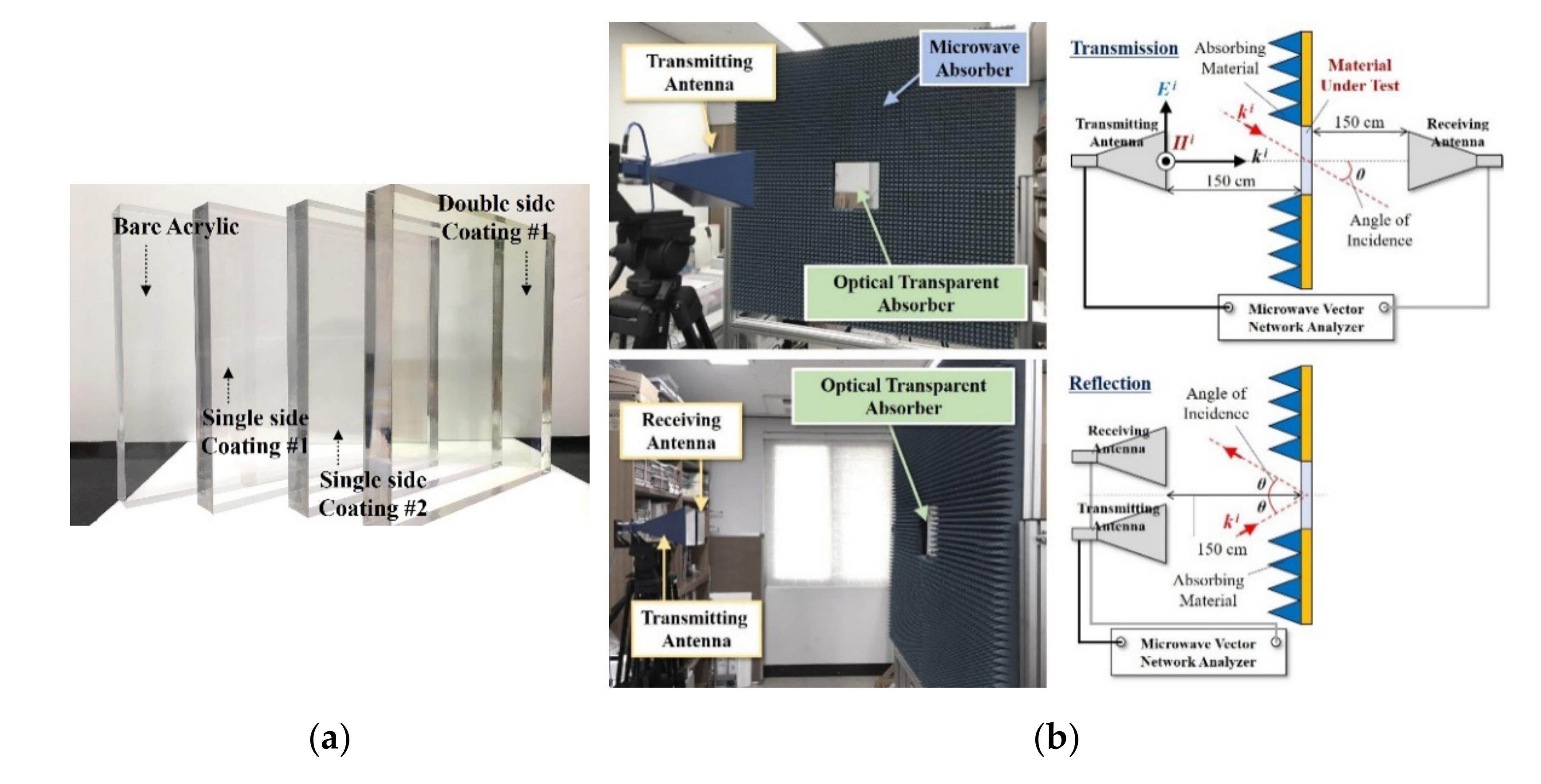
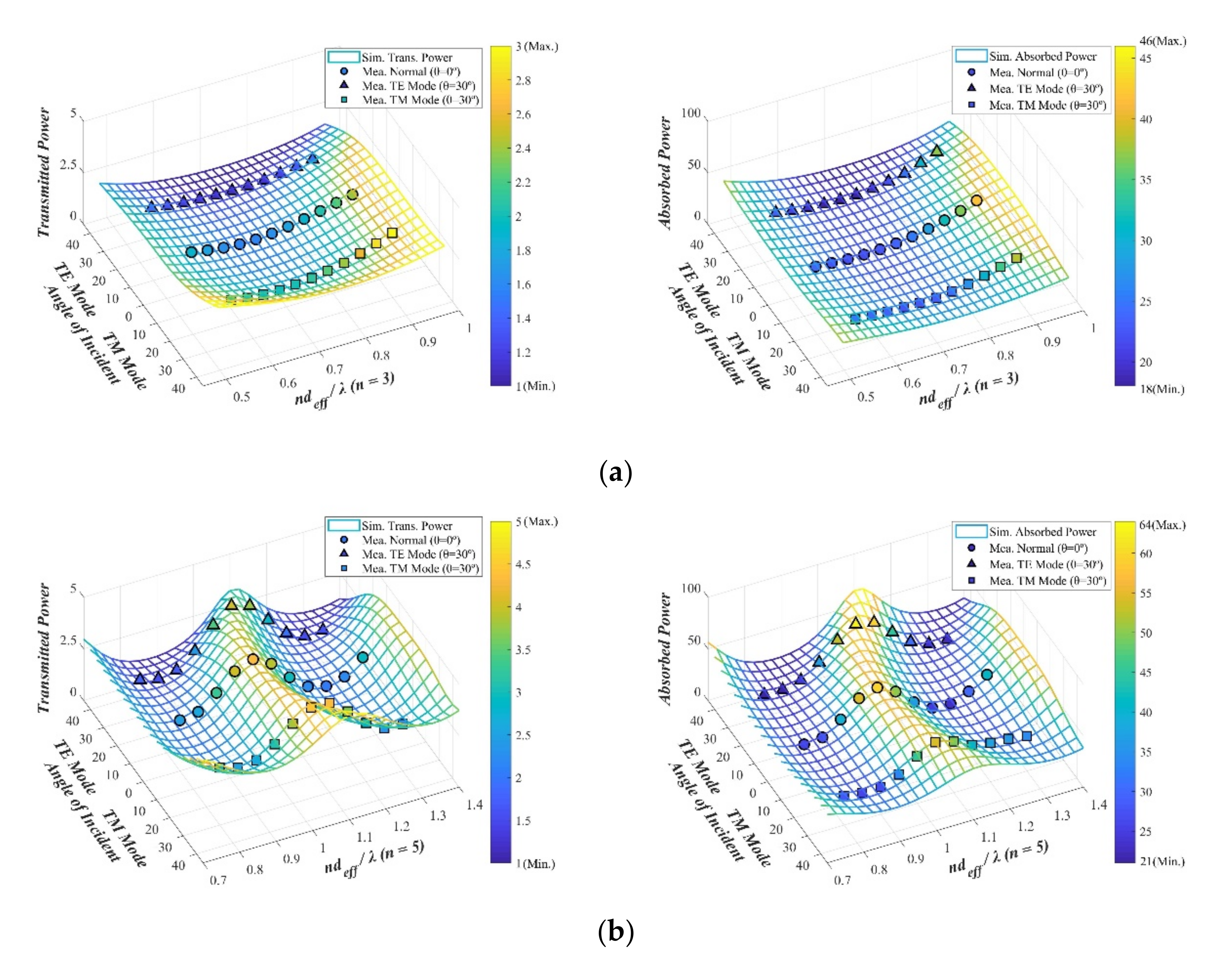
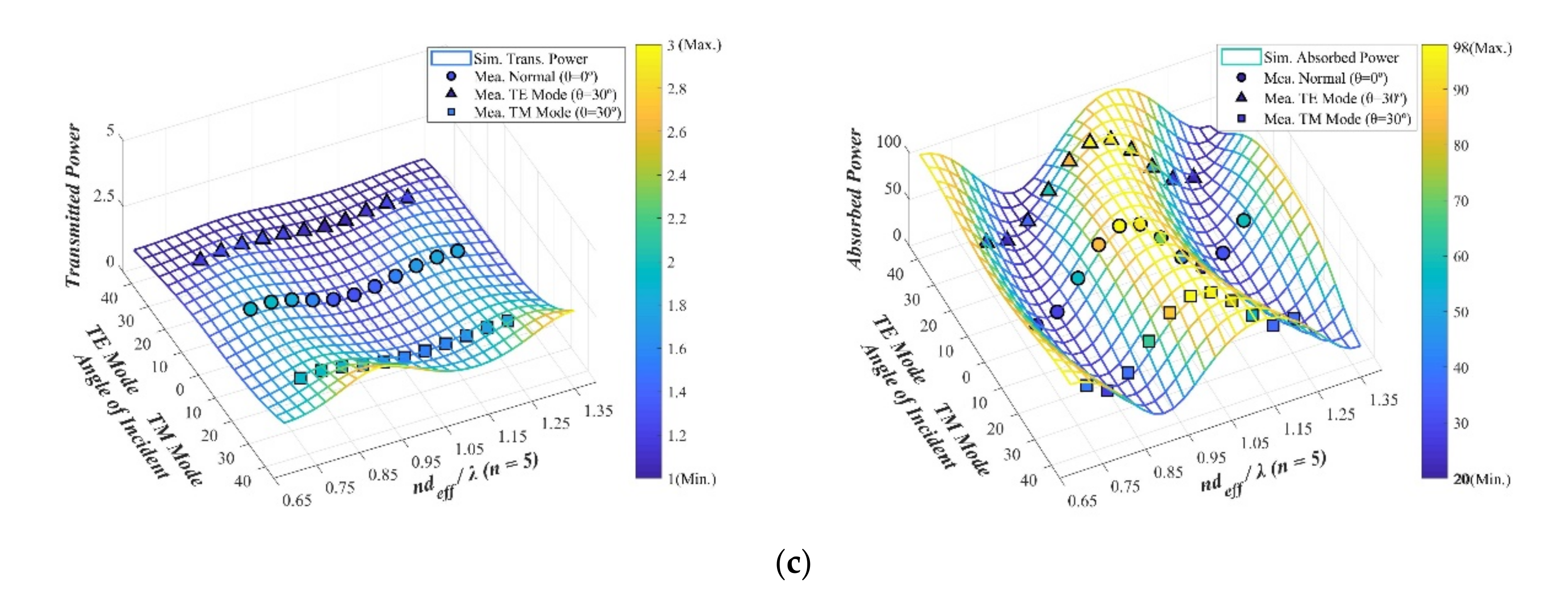

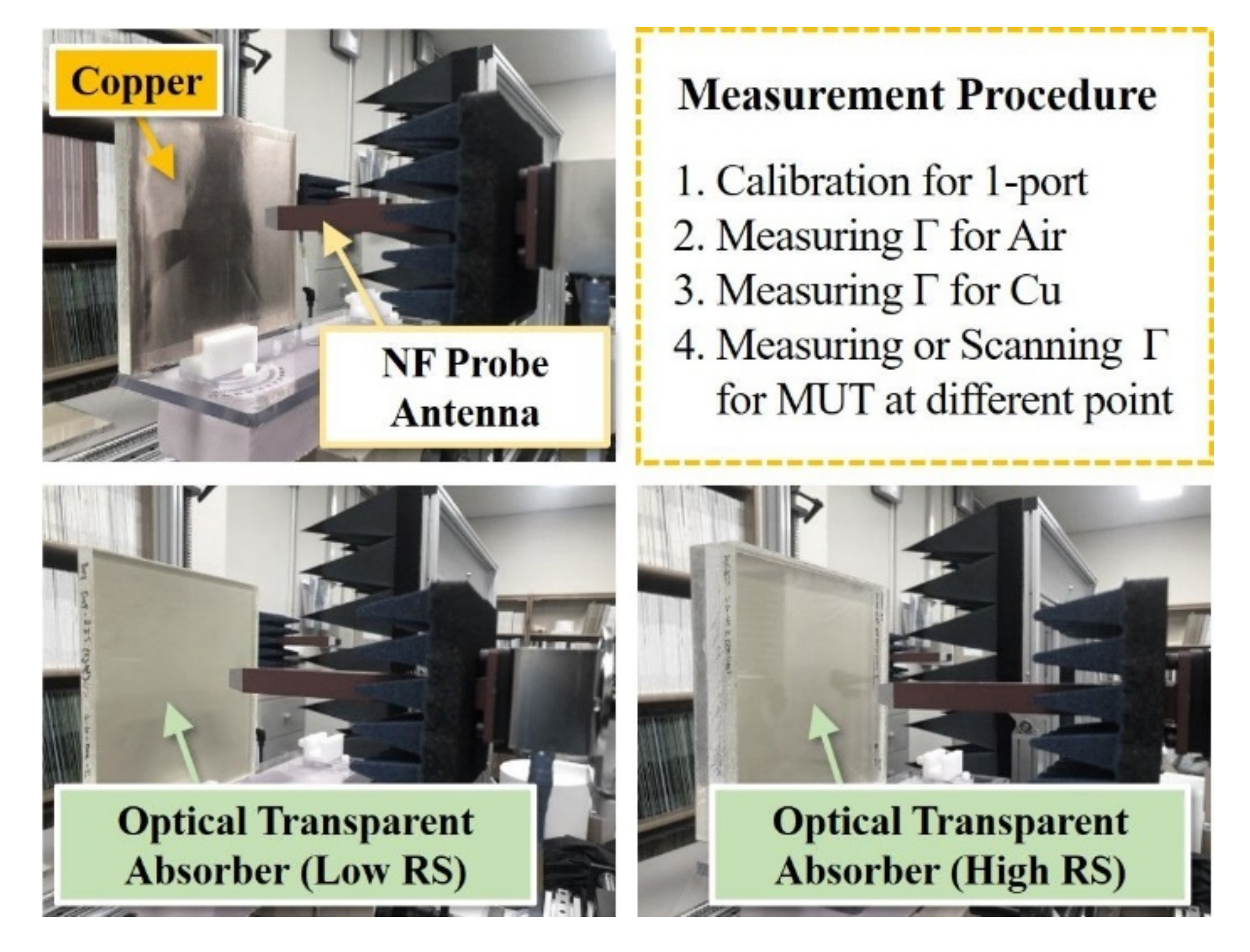
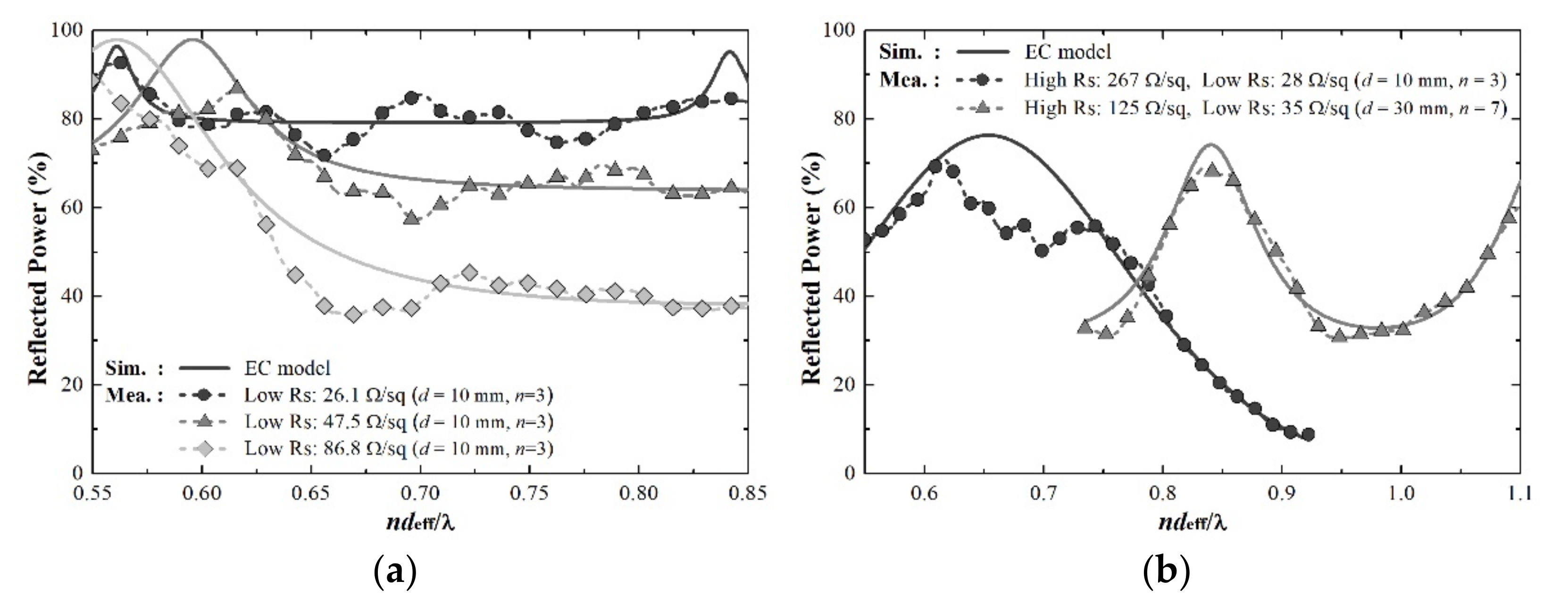
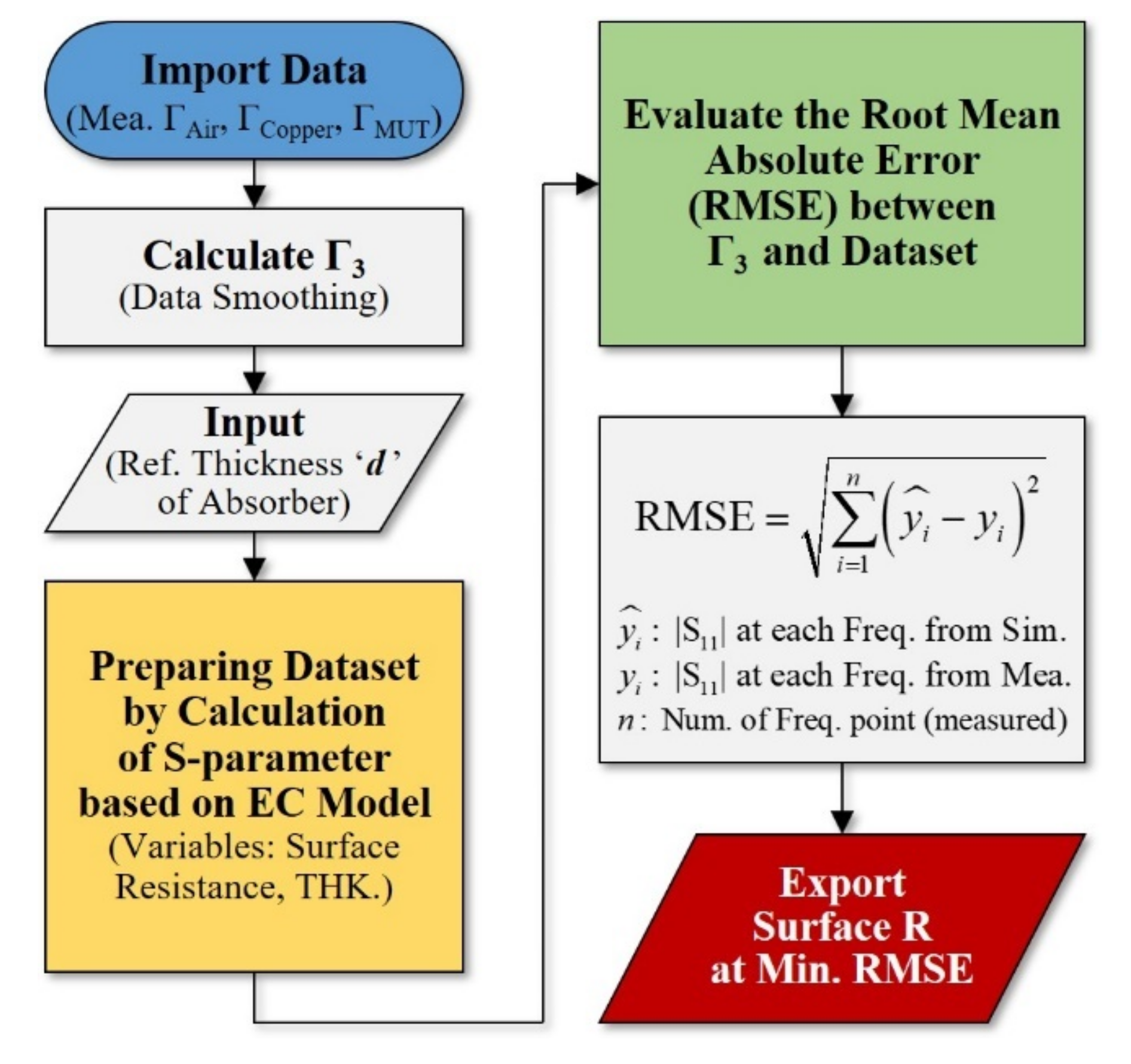

| TCO Coated Samples | Reflection Coefficient Difference | Reflected Power Difference | ||
|---|---|---|---|---|
| Thickness (d) | Measurement | Prediction | ||
| 10 mm | 26.1 Ω/sq | 22.0 Ω/sq | 0.51 dB | 0.83% |
| 10 mm | 47.5 Ω/sq | 42.0 Ω/sq | 0.82 dB | 2.64% |
| 10 mm | 86.8 Ω/sq | 89.0 Ω/sq | 1.41 dB | 2.99% |
| 10 mm | 267 Ω/sq | 232 Ω/sq | 1.47 dB | 4.68% |
| 30 mm | 125 Ω/sq | 110 Ω/sq | 0.81 dB | 1.47% |
Publisher’s Note: MDPI stays neutral with regard to jurisdictional claims in published maps and institutional affiliations. |
© 2021 by the authors. Licensee MDPI, Basel, Switzerland. This article is an open access article distributed under the terms and conditions of the Creative Commons Attribution (CC BY) license (https://creativecommons.org/licenses/by/4.0/).
Share and Cite
Lee, I.-G.; Yoon, Y.-J.; Choi, K.-S.; Hong, I.-P. Design of an Optical Transparent Absorber and Defect Diagnostics Analysis Based on Near-Field Measurement. Sensors 2021, 21, 3076. https://doi.org/10.3390/s21093076
Lee I-G, Yoon Y-J, Choi K-S, Hong I-P. Design of an Optical Transparent Absorber and Defect Diagnostics Analysis Based on Near-Field Measurement. Sensors. 2021; 21(9):3076. https://doi.org/10.3390/s21093076
Chicago/Turabian StyleLee, In-Gon, Young-Joon Yoon, Kwang-Sik Choi, and Ic-Pyo Hong. 2021. "Design of an Optical Transparent Absorber and Defect Diagnostics Analysis Based on Near-Field Measurement" Sensors 21, no. 9: 3076. https://doi.org/10.3390/s21093076
APA StyleLee, I.-G., Yoon, Y.-J., Choi, K.-S., & Hong, I.-P. (2021). Design of an Optical Transparent Absorber and Defect Diagnostics Analysis Based on Near-Field Measurement. Sensors, 21(9), 3076. https://doi.org/10.3390/s21093076






